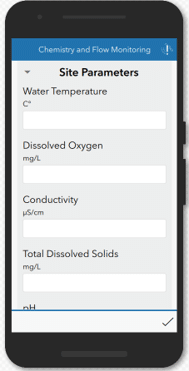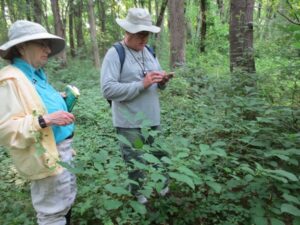
HRWC upgrades its Huron River monitoring programs
When the pandemic hit just prior to the launch of the 2020 field season, HRWC staff scrambled to find ways to advance monitoring programs while maintaining safety amidst COVID-19 uncertainties. Staff explored new methods that enabled volunteers and staff to use smartphones to digitally collect data, replacing the decades old practice of using paper and shared clipboards, and thus minimizing person-to-person interactions and equipment exchanges.
Following research on different tools, ArcGIS Survey123, a geospatial data collection tool, was selected for testing by staff and volunteer field interns during the summer’s streambank erosion assessments. Given HRWC’s prior use of ArcGIS products, Survey123 was adopted at no added cost to the organization and integrated seamlessly into existing maps and geolocated data.
During the testing phase, staff found that the new digital data collection forms improved the efficiency and accuracy of HRWC’s data collection and analysis. The transition to digital data forms sped up data processing time, minimized data processing errors, improved the accuracy of geolocated field data, and reduced paper use. Plus, as it was designed for crowd-sourced data collection, the smartphone interface was easy for volunteers and interns to use.

The success of the 2020 digital data collection testing inspired staff to expand the implementation of digital forms in 2021. In addition to the Streambank Erosion Assessments, HRWC adopted digital data forms for its Chemistry and Flow Monitoring, Natural Areas Assessment, and Green Stormwater Infrastructure Assessment programs. To support the transition to Survey123, monitoring staff developed training videos to educate volunteers and interns on the new procedures.
In 2021 four monitoring programs digitized the data collection process, saving 168 hours of manual data entry. Volunteers and staff collected 453 multipart data records digitally in the field.
Throughout the transition to digital data collection, HRWC has prioritized volunteer feedback on the new system. Across programs, HRWC volunteers and interns responded positively to the changes, stating that digital forms are easy to use and efficient. Volunteers also provided valuable feedback on monitoring protocols, trainings, and digital form design which has been used to improve procedures for the 2022 field season. As HRWC continues to utilize digital data collection for four monitoring programs, the identification of additional programs to transition to these new technologies continues to be a priority.
—Andrea Paine
This blog post was originally published March 1st in the Huron River Report, Spring 2022.



